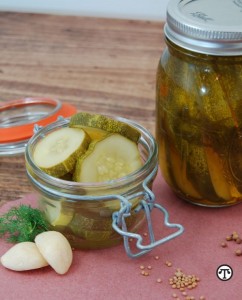 (NAPS)—Here’s a canny idea: home canning and pickling. This tasteful pastime for preserving food at home has soared in popularity, especially as part of the burgeoning Farm-to-Table movement.
(NAPS)—Here’s a canny idea: home canning and pickling. This tasteful pastime for preserving food at home has soared in popularity, especially as part of the burgeoning Farm-to-Table movement.
Now, preserving food can be easier than many people realize, and vinegar is a key ingredient. For example, “refrigerator pickling” (also known as “quick pickles”) takes just four simple ingredients and three easy steps. It’s a fun way to enjoy local or organic vegetables, particularly if you have a small amount of produce to preserve. Enjoy as side dishes for entrées, condiments for your special cocktail or for your favorite snack; share them with family and friends at your next picnic or take some along as a delicious hostess gift.
Basic Pickling Recipe
For every pound of vegetable:
1 cup vinegar
1 cup water
½ cup sugar
1 Tablespoon kosher salt
For variety, add ingredients such as fresh herbs, red pepper flakes, mustard seed, cumin seed, peppercorns, cloves of garlic, or any other pickling spice.
Preparation
Select, clean and prepare all vegetables. You can blanch them in boiling water, steam them lightly or roast them beforehand. The key is to start with crunchy vegetables. Pack all the vegetables tightly into containers with airtight lids. You can also combine more than one vegetable in the same jar if you want variety. Just make sure the flavors of the combined vegetables will be compatible because they’ll take on a bit of each other’s flavors. Bring all the brine ingredients to a boil in a small pan and pour the brine over the vegetables. Place lids on the containers, cool to room temperature, and then refrigerate for at least 24 hours before eating. This allows time for the flavors to meld. Refrigerator pickles will keep for about a month.
Depending on what produce you’re putting up and how you like it, you can use any kind of vinegar, explain the experts at The Vinegar Institute: white distilled (by far the most popular choice), apple cider, rice, white or red wine.
Learn More
For further facts and recipes, visit www.versatilevinegar.org
Cynthia Lopinto
Latest posts by Cynthia Lopinto (see all)
- Honey Chocolate–Covered Pretzels - April 3, 2018
- True Colors - April 3, 2018
- Spring Cleaning…You’ve Gotta Be Kidding - April 2, 2018
- Should You Stay In Your Home Or Move During Retirement? - April 2, 2018
- Hawaiian Plants For Good Health - April 2, 2018
 Home Front Magazine A Publication for Seniors
Home Front Magazine A Publication for Seniors

